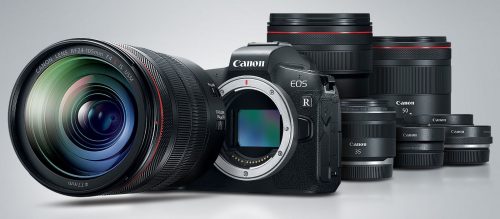Canon has finally released a full-frame mirrorless camera of its own. The EOS R will be available in October. How does Canon’s new shooter stack up to Nikon’s new Z-series cameras?
New lens mount & lenses
Nikon’s Z and Canon’s EOS RF systems both have new large mounts. The Z’s feature a new lens mount measuring 55mm in diameter with a flange depth of 16mm. This allows for the body of the Nikons to be a little more compact. They also have a new line of three Nikkor lenses that you can purchase with an adapter available for F-mount lenses. The EOS RF mount measures 54mm with a flange depth of 20mm. Canon has released 4 lenses with more wide-aperture options among these than Nikon’s Z series. There is an adaptor available for existing optics as well.

Video
Mirrorless cameras are as popular for stills as they are for video, so it was important that both Nikon and Canon integrate good video specifications. Both can record 4K up to 30fps. In Full HD, the Z6 goes up to 120fps with slow motion capabilities, whereas the Canon stops at 60fps. Both cameras have 3.5mm mic input and audio out connectors.
Viewfinder & rear screen
Both models have been furnished with electronic viewfinders, and both have OLED panels with a resolution of 3.69 million dots. The Nikon Z7’s viewfinder has 0.80x magnification, and the EOS R has 0.76x magnification. Both cameras feature a rear LCD screen with 2.1M dots and touch sensitivity. The one on the Nikon is slightly larger at 3.2 vs 3.15 inches on the Canon. More important, the Z6 has an up-and-down tilting screen whereas the one on the EOS R is multi-angle. It can be orientated to the side, which is usually preferred among filmmakers.
 Speed
Speed
Both have a fast burst rate making them perfect for taking action shots. The Nikon Z7 has a 1fps advantage over the EOS R, with 9fps. Switch to continuous focus and the Z7 can maintain its 9fps burst speed. Canon has 8fps burst rate. Switch to continuous autofocus and the EOS R drops to 5fps.
Stabilization
The Z6 features internal sensor shift. The sensor moves on five axes to compensate for camera shakes. The sensor-based stabilization allows you to benefit from the technology even when using older lenses. Image stabilization has been built into two of the four lenses released alongside the EOS R, not within the body. Therefore, EOS R must rely on optical stabilization.
Autofocus
Both cameras use on-sensor phase detection technology. The Nikon Z’s feature an autofocus system with over 400 AF points. The EOS R, however, uses a record-breaking 5,655 points which is higher than any other camera on the market!
In the battle of these camera brands, we are the winners. It’s a very good time to be a photographer!

Right here is the right site for anyone who hopes to find
out about this topic. You understand so much its almost tough
to argue with you (not that I personally would want to…HaHa).
You certainly put a new spin on a subject that has been discussed for years.
Wonderful stuff, just great!